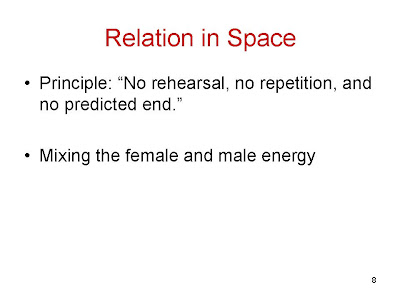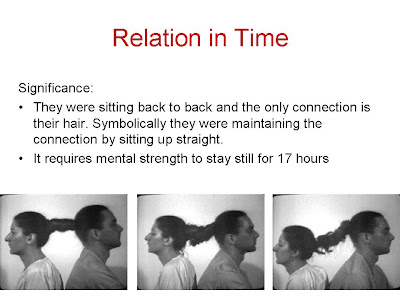
2. Marina Abramovic was a female performance artist who was born in Belgrade, former Yugoslavia and modern day Serbia, in 1946. She was an important figure within performance art history back in the 70s, as she regarded herself as "Grandmother of performance art". Most of her performances, especially her early ones, aim to push her body to extreme and show the limitation of the human body. She also explored the relationship of the body and the mind. Occasionally she performed to test the limits of the relationship between performer and audience. In 1976, she moved to Amsterdam, The Netherlands, and met Ulay.

3. Ulay, born Frank Uwe Laysiepan, is usually being addressed on by the short form of his last name, Ulay. He was born in Solingen, Germany, in 1943. All through his career he moved from places to places and collaborated with local artists there. Other than performance art, he also creates artwork using photography. In his performance art pieces he usually explored the relationship of body and space.

4. Marina Abramovic and Ulay were actually born on the same day, November the 30th. They were both significant performance artists in the 70s. Once they’ve met they started their long 12 years of collaborative work, starting from 1976 till 1988, which is the year they ended their relationship. They were both interested in the relationship of body and the mind.

5. Back in the 70s, Performance art's popularity is growing both in America and Europe. There are more and more new generation of performance artists. And many famous performances at that time are regarded as shocking and irritating, for example, there are always artists doing self-destruction performances like cutting themselves on the body. Some even engaged in performances that put their own lives at risk. Like Rhythm 5 performed by Abramovic. The artist laid herself surrounded by burning flames which she almost died of suffocation.

7. [A video excerpt of the performance]

8. This art work is based on a principle, which is "No rehearsal, no repetition, and no predicted end". As claimed by the Abramovic, that she represents female energy, and Ulay represent the male energy. By collision the mix the two energy.

9. Another work to introduce is "Relation in Time". It was from the same series as "Relation in Space". It was performed at G7 Studio in Bologna, Italy. In this performance the artists sit back to back for 17 hours with their hair tied together. The first 16 hours was performed without audiences. After that the audiences were let in and they sat for another hour before ending the performance. At the start of the seventeen-hour performance, they were sitting up straight. Later, when fatigue sets in, Abramovic, in particular, begins to slump a little, so that their hair, which was tied together tightly, begins to become looser.
10. [A video excerpt showing different stages as the performance wears on]

11. In my opinion, what "Relation in Time" tries to bring out is relation between two people over time. During performance, the two artists are sitting back to back and the only connection is their hair. Symbolically they were maintaining the connection by sitting up straight. And It requires mental strength to stay still for 17 hours, as you see that some time later Abramovic slumped and the tied hair is loosen. This makes me think that maintaining connecting is requiring lot of power over your mind and body to actually accomplish it.

12. And I think it also brings out how relation can't be kept lacking well physical condition no matter how your mind wants to. This is so typically Abramovic as she has a history of pushing her body's limit to extreme to explore the constraint of physical body in her performances.
 13. Another work to introduce is "Breathing in, Breathing out".
13. Another work to introduce is "Breathing in, Breathing out".
14. "Breathing in, Breathing out" was first performed in Belgrade, in April 1977. Indeed, during the performance, the artists' nostrils are blocked by cigarette filter, so they are unable to breathe in flesh air with their noses. Then they press their mouth together for 20 minutes just rely on the air each other breathes out. Until all the oxygen in that one breath of air is used up, they collapsed.


16. In fact, they both passed out at the end. It shows limits of the body: lack of oxygen that leads to asphyxiation, and you just can't go on performing even if your will want you to. They are again testing body limits. It also metaphorically show how two people can wear each other out.
 18. This is a screen capture of the official video clip for "Relation in Space". This shows how the scene on the periphery are cut out, you cannot see the way Abramovic and Ulay prepare themselves for the next collision.
18. This is a screen capture of the official video clip for "Relation in Space". This shows how the scene on the periphery are cut out, you cannot see the way Abramovic and Ulay prepare themselves for the next collision.
19. Abramovic herself has actually stated that documentation cannot be a substitute for live experience, as it is unreliable and can lead to "total mystification and misrepresentation of the actual events." And she didn't filmed or photographed her early performances due to this belief.

20. Sometimes I really don't get those performance art. Especially those involve artists inflicting harm on themselves. I understand sometime there is a symbolic meaning within. But sometimes I think artists are trying to get an effect or attention, along with their naked bodies because the act is shocking, and people pay attention to it thus amplifies the effect of the performance.

21. [My view on their] Collaboration:
I think the duo, Amramovic and Ulay, is a good example of two artists that have similar views and direction and abilities, unlike those other artwork introduced in the class that one artist is specialised on a specific field. And many of their performances require two people. It's not like creating a product, but actually perform together. This vividly illustrates collaboration.
































